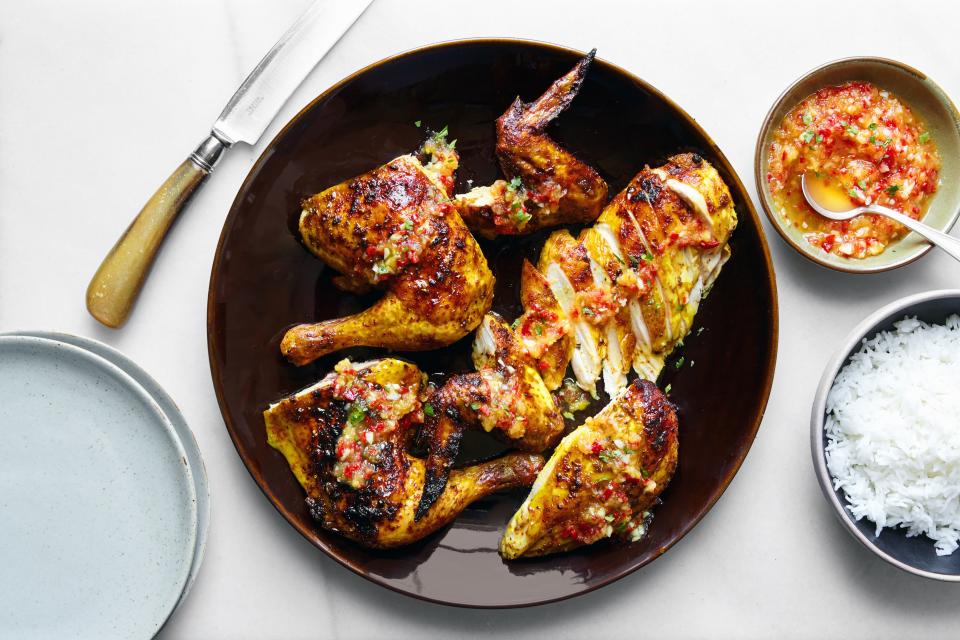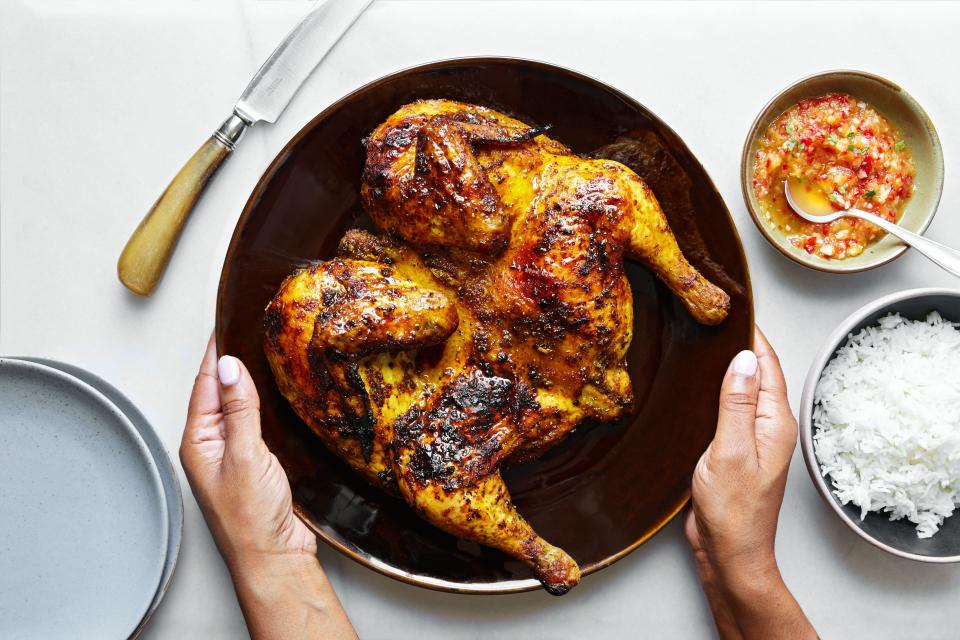How to Make Bangkok’s Best Thai Muslim-Style Grilled Chicken at Home
Hindered by myriad factors, most Thai restaurants in the West—the de facto ambassadors of the cuisine—shy away from the country’s vast and diverse collection of grilled dishes. You may be familiar with Northeastern Thai (Isan) grilled chicken, served with fiery green papaya salad, but it’s possible you’ve never tasted southern Thai grilled chicken that’s basted with a sweet and sour coconut-based curry sauce as it’s grilled, a Thai Muslim-style grilled chicken brushed with saffron-infused oil, or the turmeric grilled chicken of western Thailand—semi-boneless and stretched taut between partially split bamboo wood. But there’s good news: Your backyard or patio is a perfect entry point to the world of Thai grilling, and the equipment that you need to produce superlative Thai grilled chicken is most likely already in your possession.
One thing these various traditions have in common is the use of a wet paste of fresh herbs and aromatics as the core seasoning (the use of dry rub is a rarity in Thai cuisine). And though the paste ingredients vary, at the center of the Venn diagram are garlic, peppercorns, and cilantro roots—the trifecta of flavors embedded in countless Thai seasoning and curry pastes.
These grilled chicken recipes also share an essential technique: The whole bird is spatchcocked, through the breast, to lay flat on the grill.
How to spatchcock a chicken the Thai way
In the West, to spatchcock a bird, one would typically open up the bird from the back by cutting along both sides of its backbone. The back is then usually kept for making stock or thrown out, and the breast is kept intact. In Thailand (as well as in Laos, Cambodia, Malaysia, and Singapore), birds are spatchcocked the opposite way—the cut is made on the breast side, along one side of the keel bone.
I once observed a very skilled street vendor butterflying chickens by standing one upside down on his chopping block and, in one swift motion, splitting it down the center starting from the triangular area where the base of the two breasts are conjoined, severing the wishbone as the blade of the cleaver hit the chopping block. With this kind of dexterity, you can spatchcock ten birds in less than a minute. At home, though, you can take your time, laying your chicken on its back on the chopping board. I find a heavy-duty pair of kitchen shears to be the most convenient tool.
The chicken will be a tad lopsided because, unless you can halve the keel bone lengthwise with laser-like precision, the bone will be attached to only one of the breasts. But symmetry, in this case, is overrated; the values gained from this method far outweigh the lopsidedness. For one thing, when the chicken is spatchcocked this way, you don’t risk losing the oysters, the tender, juicy, roundish pieces of dark meat near the thigh joints, which tend to slide out during the cooking when the thighs are separated from the backbone. Also, this method allows both the backbone and the little tail end to remain intact. This narrow strip of poultry real estate, comprising mostly skin and bones of various degrees of chewability, exponentially increases its values once grilled or roasted. This fact is long recognized by lovers of crisp skin, gnawers of bones, and devotees of charred and smoky nubbins.
The Best Thai Muslim-Style Chicken in Bangkok
Thai Muslim-style grilled chicken features both of the characteristics mentioned above. This tradition originated from the communities of Thais of Islamic faith with ancestral lines tracing back to South Asia, Persia, or the Malay Peninsula. (In Thailand, these people identify as Thai Muslims and, despite the nuanced differences between their culinary traditions, explicitly call both their shared culinary heritage and their food businesses "Muslim.") Thai Muslim cuisine, including the seasoning of this grilled chicken, is where you find an interplay of the traditional Thai herbs with aromatics and dried spices that aren’t prominently used in much of Thai cuisine, such as cardamom, cinnamon, allspice, turmeric, and saffron.

Jirapan Chicken - INSET
And out of this genre of grilled chicken, emerged the inspiration behind this recipe. Since 1943, a family from Ayutthaya, a neighboring province of Bangkok, has grown their grilled chicken business, Jeerapan, from a humble shack to a prominent restaurant known for arguably the best Thai Muslim-style grilled chicken in Bangkok, if not all of Thailand. I grew up eating Jeerapan chicken, and every trip I make from my current home in Chicagoland to visit my birthplace these days includes a meal of it.
As a kid, admittedly, I was drawn to the sweet chile sauce, the constant companion to most types of Thai grilled chicken, which I could tell was different at Jeerapan. As I grew older and my senses matured, I began to notice and better appreciate the juicy and well-seasoned chicken meat—fragrant with fresh herbs, aromatics, and dried spices—and the crisp, flavorful, and vibrantly-colored skin. I also came to realize that the presence of pineapple, an atypical ingredient for the standard Thai sweet chile sauce, is what makes Jeerapan’s dipping sauce stand out.
But it wasn’t until I started writing about food over a decade ago that I dug deeper into Jeerapan and learned that their flagship product is produced by a 2-step cooking method. The initial step involves roasting the chicken in moderate heat using the South Asian tandoor oven. During this time, the meat becomes nearly cooked through, and the skin has most of its fat rendered out and is thus perfectly primed to finish cooking—and crisp up—over wood charcoal. As for the canary-colored skin, according to the restaurant’s spokesperson in various interviews, it’s all thanks to a basting liquid that features saffron threads.
Now, saffron is an ingredient that’s almost never used in Thailand outside the Thai Muslim communities. And it’s as expensive and hard to find there as it is in most places in the world. If saffron’s not an option for you, ground turmeric is a perfectly acceptable substitute.
You’ve got options when it comes to cooking implement as well. You can make Jeerapan-style chicken from start to finish on a charcoal or gas grill, using the 2-zone cooking method and keeping the lid on, thus converting your grill into an oven. To crank up the grill temperature for the final stage, turn on all the burners on the gas grill or open the lid and all the vents of your charcoal grill to quickly stoke the fire thanks to oxygen flow. Those who don’t have a grill or don’t want to grill outside in the cold this winter can do the whole thing in a home oven, roasting the chicken at moderate heat then, toward the end, use the broiler to sear and crisp the skin. Your chicken will still be delicious this way, albeit a bit deficient in the smoky-flavor department. This minor issue can be ameliorated by using the dhungar method, a South Asian way of perfuming ingredients and finished dishes indoors with smoky ghee.
Thai Muslim–Style Grilled Chicken
Originally Appeared on Epicurious


